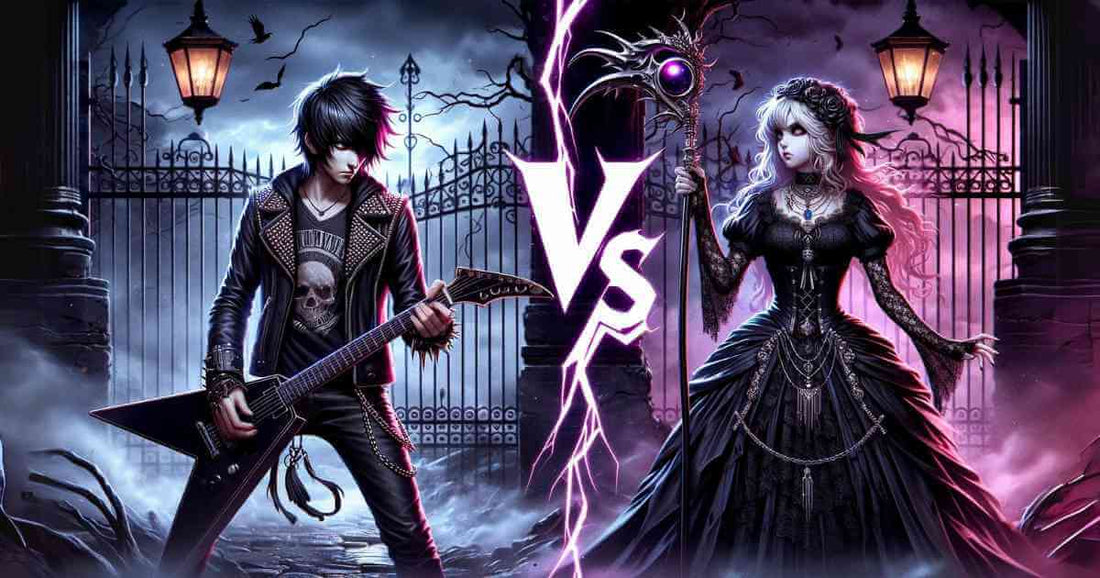Emo and goth: two distinct subcultures that often get mistaken for one another.
Let’s dive into their unique worlds! Ever found yourself mixing up emo and goth styles?
You're not alone!
This guide will illuminate the key differences, making you an expert in no time.
Key Takeaways
- Historical Roots: Exploring the origins and evolution of emo and goth.
- Fashion Statements: Distinguishing between emo and goth fashion styles.
- Musical Influences: Contrasting the music styles and themes prevalent in emo and goth.
- Lifestyle and Philosophy: How emo and goth subcultures differ in their approach to life and community.
Differences Between Emo and Goth in History
What is the History of Emo?
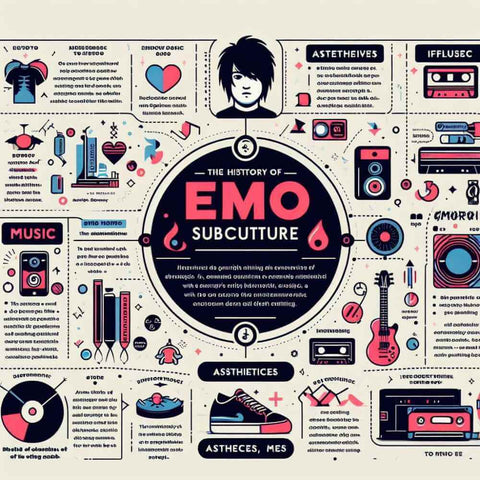
Picture this: Washington D.C., mid-1980s. The air is electric with the raw energy of hardcore punk, a scene bustling with rebellion and high-octane music.
It's here, in this vibrant chaos, that emo takes its first breath. Emo, short for 'emotional hardcore', isn't just a music genre; it's a profound expression of feelings, a way for artists to pour their hearts out in a melody.
Bands like Rites of Spring and Embrace took the helm, steering punk's unbridled energy into a more introspective direction.
Their lyrics, intense and personal, resonated with a generation seeking a deeper emotional connection with their music.
As we fast forward to the early 2000s, emo makes a striking transition. It evolves, weaving its way into the fabric of mainstream music.
Bands like My Chemical Romance and Fall Out Boy become the new faces of emo, introducing the world to a more polished, indie rock-infused version of the genre.
Emo, once an underground movement, is now a global phenomenon, echoing through the headphones of millions.
What is the History of Goth?
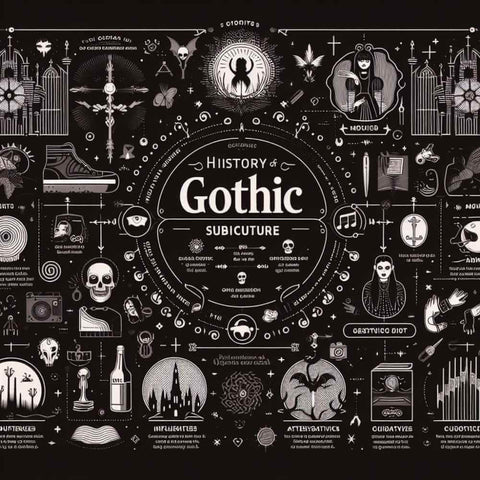
Now, let's teleport to the UK in the early 1980s. The post-punk scene here is brewing something different.
If emo is a heart-on-sleeve declaration, goth is a soulful introspection, draped in shadow and mystery. Goth culture, with its dark aesthetics and introspective themes, is like a painting that uses a palette of melancholy and elegance.
Bands such as Siouxsie and the Banshees and Bauhaus lay the cornerstone of goth music. Their sound is an intricate tapestry of melancholic tunes and introspective lyrics, often delving into themes of existentialism and the supernatural.
Goth music doesn't just stay within the confines of audio; it spills over, influencing fashion and lifestyle.
The goth subculture evolves into a rich and diverse tapestry, giving birth to subgenres like cyber goth, each adding its unique hue to the goth spectrum.
The influence of goth music and culture extends far beyond its community, leaving an indelible mark on the broader landscape of art and fashion.
In this era full of individuality, Gothic culture has subtly infiltrated our daily lives with its unique, dark allure. From mysterious, elegant clothing—like distinctive hats and necklaces—to intricately designed daily items, such as notebooks and luggage tags, the influence of Gothic aesthetics stands out.
Customized luggage tags, for instance, allow you to merge Gothic culture with personal expression, engraving your name or favorite Gothic motif to make every journey not only safe but also uniquely yours.
Key Differences
| Emo | Goth |
|---|---|
| Mid-1980s in Washington, D.C. as a style of hardcore punk and post-hardcore | Early 1980s in the United Kingdom, evolving from post-punk |
| Rites of Spring, Embrace, Sunny Day Real Estate, Jawbreaker, Cap'n Jazz, Jimmy Eat World | Siouxsie and the Banshees, Bauhaus, The Cure, Joy Division, The Sisters of Mercy |
| Transitioned from hardcore punk to incorporating alternative, indie, punk, and pop-punk influences in the 1990s; Emo pop and screamo subgenres emerged in the 2000s | Started as gothic rock with influences from punk, new wave; diversified into death rock, dark wave, ethereal wave; 1990s saw expansion into subgenres like cyber goth, gothic metal |
| Developed a distinct subculture emphasizing emotional expression, introspection, and personal authenticity; Fashion includes skinny jeans, eyeliner, band t-shirts | Long-lasting subculture with a focus on dark aesthetics, individualism, and the macabre; Fashion influenced by punk, Victorian, Edwardian styles; Emphasis on dark attire and makeup |
| Entered mainstream culture in the early 2000s with bands like My Chemical Romance and Fall Out Boy; faced decline and revival in the 2010s | Maintained a consistent presence, especially in European and American scenes; influenced various music genres and fashion trends throughout the decades |
Differences Between Emo and Goth in Fashion
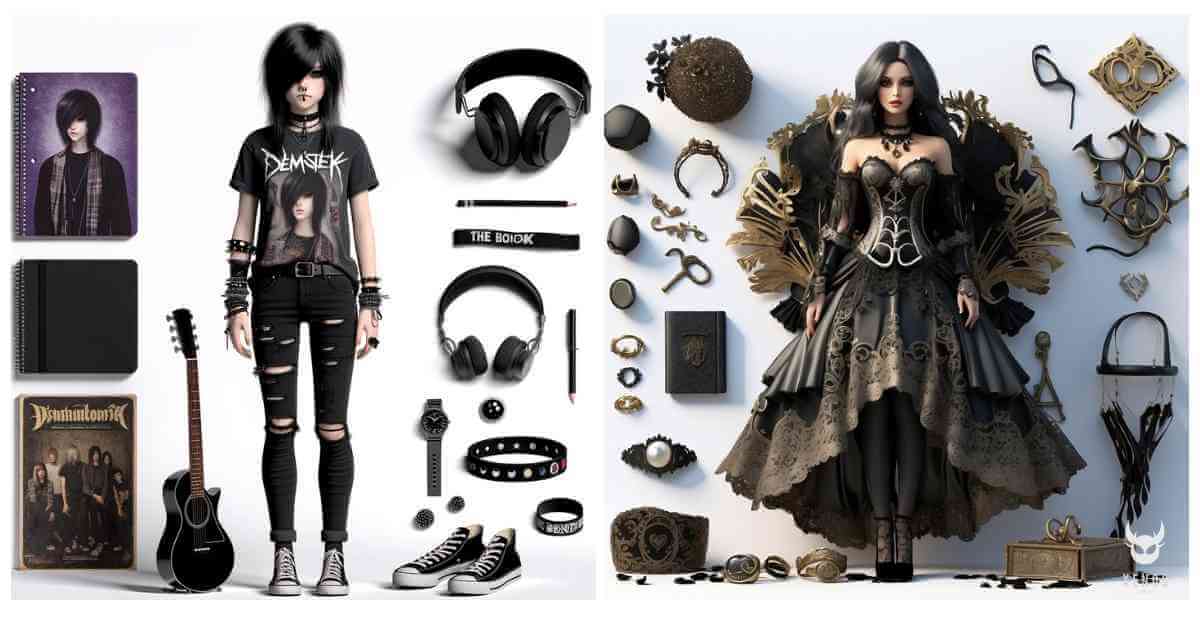
Fashion is the banner under which both emo and goth proudly declare their identities. It's more than just clothing; it's a visual language, telling stories of subcultural belonging.
Emo Fashion

Emo fashion is like a visual diary entry, candid and deeply personal. It's characterized by its casual, sometimes disheveled look, echoing the raw emotions of the music.
Think skinny jeans, band T-shirts, often includes accessories like wristbands and canvas sneakers. The color palette leans heavily on black, accented with pops of bright colors, reflecting the emotional intensity of the genre.

Custom Enamel Pins featuring rock elements can be a trendy fashion statement that fits Emo fashion well. Whether you pin it to your jeans or hat, it exudes a rock 'n' roll vibe and offers a unique expression of your inner self. In addition, you also have a wider range of choices available, such as Custom Patches.
Hairstyles are a crucial aspect, often featuring side-swept bangs or dyed hair, symbolizing the individuality and emotional depth of the wearer.
The evolving trends in emo fashion can be further explored in our detailed guide on men's edgy haircuts.
To dive deeper into the emo influence in fashion and culture, you can explore more about grunge style for men.
Goth Fashion
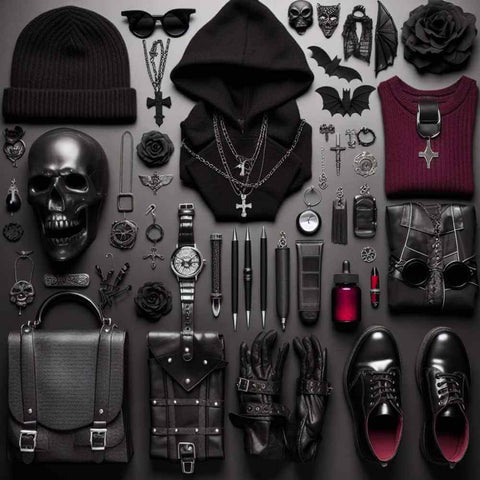
Goth fashion, on the other hand, is an ode to the elegant and the mysterious.
It draws inspiration from various historical periods, blending Victorian and Edwardian influences with modern punk and industrial elements.
The goth wardrobe is a tapestry of black lace, velvet, leather, and corsets, adorned with intricate accessories like chokers and silver jewelry.
The makeup is often dramatic, with pale foundation and dark lipstick, creating a look that's both haunting and beautiful. Goth fashion isn't just a style; it's a statement of artistic and philosophical depth.
Key Differences
| Emo Fashion | Goth Fashion |
|---|---|
| Skinny jeans, band T-shirts, studded belts | Black clothing with lace, leather, and velvet |
| Dyed black hair, sometimes with bright streaks, minimal makeup | Dark hair, heavy eyeliner, dark lipstick, often black |
| Wristbands, canvas sneakers, often converse | Platform boots, silver jewelry, chokers, laced corsets |
| Punk rock, indie rock, alternative styles | Punk, Victorian, Edwardian, and New Romantic styles |
| Predominantly black with occasional bright colors | Almost exclusively black, occasionally with dark reds or purples |
| Emotional expression, individuality, and authenticity | Eerie, mysterious, complex, and often genderless features |
| Influenced by music bands and artists from emo and pop-punk genres | Influenced by figures like Siouxsie Sioux, Robert Smith, and other goth rock icons |
Differences Between Emo and Goth in Music
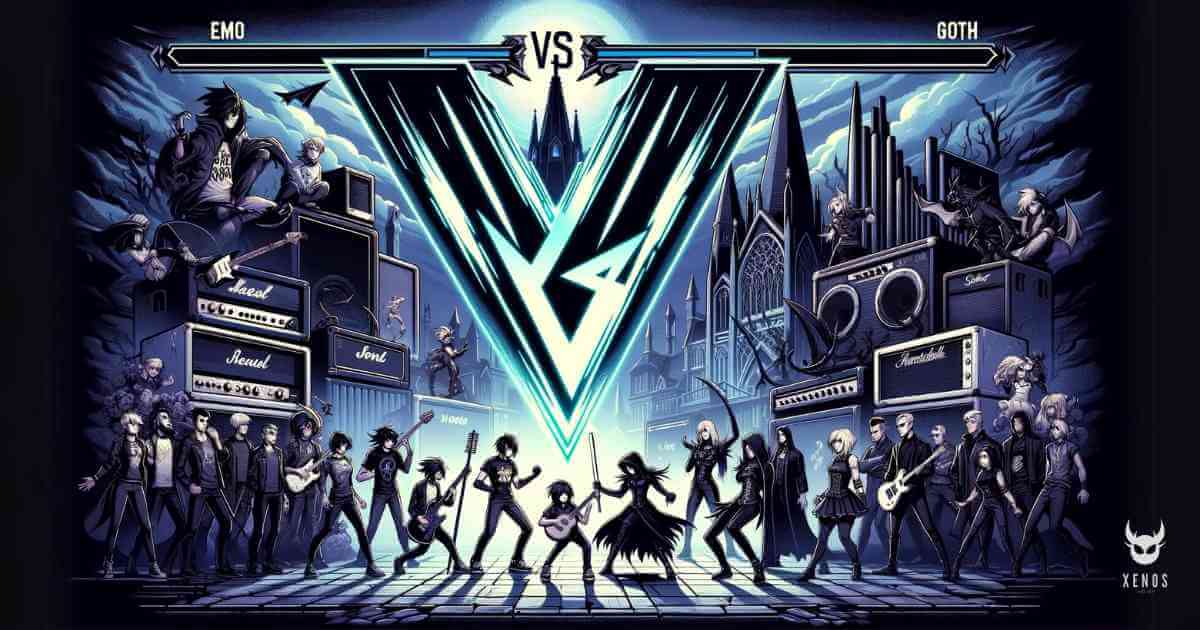
Emo and Goth are two subcultures that emerged from the punk rock movement of the late 1970s and continue to influence art, culture, and media around the world.
While both subcultures share some similarities, they differ in their musical styles, influences, and themes.
Emo Music Style
Emo music, with its punk roots, is a raw, unfiltered stream of consciousness. It's where the turmoil of the heart meets the energy of punk.
Bands like My Chemical Romance and Paramore become the standard-bearers of this genre, their lyrics often a narrative of personal struggle, introspection, and the vicissitudes of life.
The emo sound is a blend of aggressive guitar riffs and emotive lyrics, a canvas where each song paints a story of emotional depth.
Goth Music Style
Goth music, in contrast, is an ethereal journey into the depths of the soul.
Bands like The Cure and Joy Division become synonymous with the goth sound, their music a fusion of atmospheric melodies and brooding lyrics.
The themes often explore the realms of existentialism, romance, and the supernatural, wrapped in a cloak of moody, melancholic soundscapes.
Goth music is more than just sound; it's an auditory exploration of the darker side of human emotion.
Explore these subcultures through documentaries like Goth Cruise (2008), American Emo (2013), and The Decline of Western Civilization Part III (1998).
If these are unavailable in your region, learn how VPN works to unlock content and access these unique insights into goth and emo cultures from different locations.
Key Differences
The table below summarizes the differences between Emo and Goth music styles:
| Emo Music | Goth Music |
|---|---|
| Punk, indie rock, pop punk | Post-punk, darkwave, industrial |
| My Chemical Romance, Fall Out Boy | The Cure, Bauhaus |
| Personal struggle, relationships, emotional turmoil | Existentialism, supernatural, introspection |
Differences Between Emo and Goth in Lifestyle
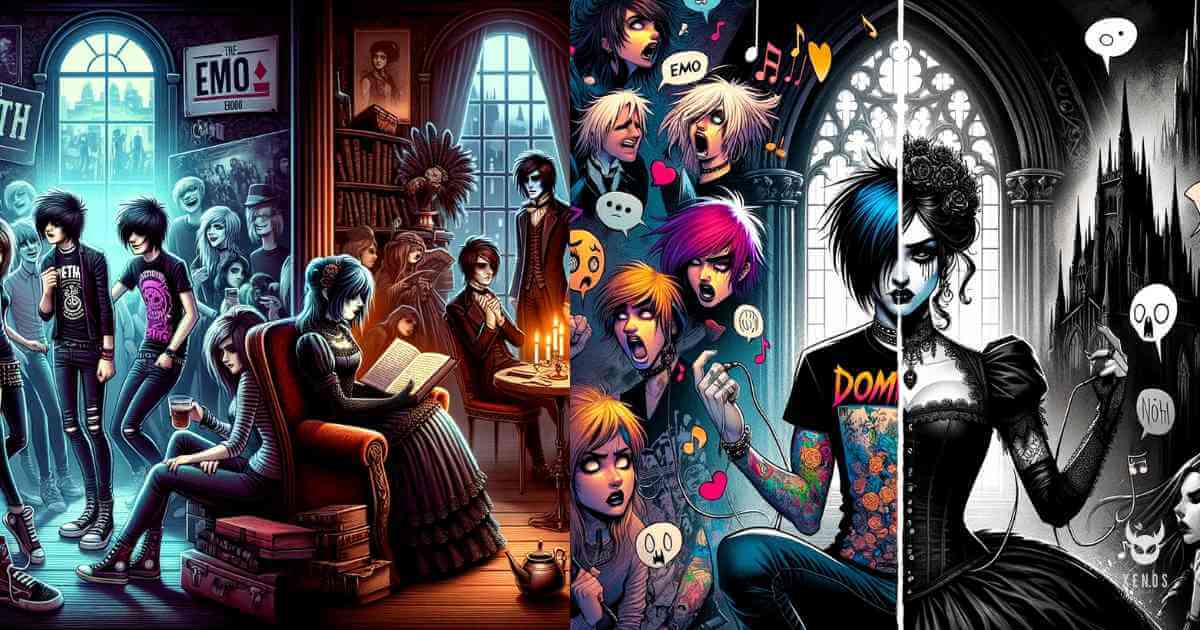
The emo and goth subcultures extend far beyond their musical and fashion preferences. They are lifestyles, each with its unique ethos and community.
Emo Lifestyle and Philosophy
The emo lifestyle is built around community and self-expression. It's a space where emotions are embraced, not shunned.
Emo culture encourages open dialogue about feelings and experiences, often through art, poetry, and music.
The community aspect is strong, with fans bonding over shared musical tastes and life experiences. Emo isn't just about looking a certain way; it's about authenticity, about being true to one's emotions and experiences.
Goth Lifestyle and Philosophy
The goth lifestyle is an exploration of art, philosophy, and individuality.
It's a culture that values deep thinking and introspection, often finding beauty in the darker aspects of life.
Goths are known for their love of literature, art, and philosophy, exploring themes of existentialism, romance, and the supernatural.
The goth community is diverse, welcoming various interpretations of the goth ethos. It's a subculture that celebrates individuality, encouraging its members to explore and express their unique perspectives on the world.
Key Differences
| Emo Lifestyle | Goth Lifestyle |
|---|---|
| Emotional expression, personal authenticity | Individualism, appreciation for the macabre |
| Shared emotional experiences, vulnerability | Shared interests in music, fashion, alternative lifestyles |
| Poetry, art, music that deal with themes of alienation, loneliness, depression, and self-harm | Music, literature, art, and cinema that explore themes of horror, fantasy, romance, and death |
| Sensitive, shy, introverted, or angry. May suffer from low self-esteem, anxiety, or depression. May use self-injury or suicide as a coping mechanism or a form of protest | Introverted, creative, intelligent, or mysterious. May have a sense of humor that is dark, ironic, or sarcastic. May have an interest in occultism, paganism, witchcraft, or vampirism. May have a fascination with death, decay, graveyards, or the supernatural |
Conclusion
In the vast landscape of subcultures, emo and goth stand out for their distinctive historical roots, fashion statements, musical influences, and lifestyles.
This exploration into their worlds reveals more than just surface-level differences; it uncovers the depth and richness of these subcultures.
As we conclude this deep dive, it's clear that both emo and goth continue to influence and inspire. They remind us of the power of subcultures to shape identities, forge communities, and challenge societal norms.
In understanding their differences, we gain a greater appreciation for the diversity of human expression and the myriad ways in which we can find connection and meaning in our lives.
For more inspiration on how to incorporate emo and goth elements into your wardrobe, check out our collection of grunge outfits.
FAQs
Can someone be Goth and emo?
Yes, it's possible for someone to identify with aspects of both goth and emo subcultures. While they have distinct origins and characteristics, there's a crossover in themes of emotional expression and alternative aesthetics. Some individuals may find that elements of both goth and emo resonate with their personal style and outlook, blending the two in their fashion, music preferences, and lifestyle.
Is Goth punk or emo?
Goth originally emerged from the post-punk scene in the early 1980s, distinct from emo, which developed from the hardcore punk scene in the mid-1980s. While both have roots in punk, goth and emo evolved as separate subcultures. Goth focuses more on dark, introspective themes and elegant aesthetics, whereas emo is more closely associated with expressive emotional authenticity and a more casual fashion style.
Is Lil Peep emo or goth?
Lil Peep was often associated with the emo rap genre, a fusion of hip-hop, punk, and emo influences. His music and style were characterized by themes of emotional distress and vulnerability, aligning more with emo characteristics. While he incorporated a variety of styles in his music and fashion, he is more closely related to emo rather than goth.
Is goth older than emo?
Yes, goth is older than emo. The goth subculture began in the early 1980s, evolving from the post-punk movement, whereas emo originated in the mid-1980s as a style of hardcore punk. This makes goth slightly older than emo in terms of their respective emergence as recognized subcultures.
Do goths listen to metal?
Goths often enjoy a wide range of music, including various forms of rock and alternative music. While traditional goth music is more closely related to post-punk and darkwave, some goths do listen to metal, especially genres like gothic metal, which blends elements of goth rock and heavy metal. However, metal is not a defining characteristic of goth music, and preferences can vary widely among individuals within the goth community.

